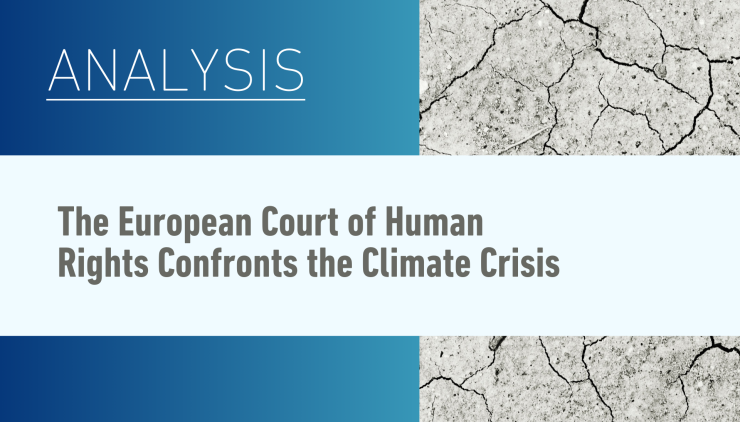This website uses cookies so that we can provide you with the best user experience possible. Cookie information is stored in your browser and performs functions such as recognising you when you return to our website and helping our team to understand which sections of the website you find most interesting and useful.
The European Court of Human Rights Confronts the Climate Crisis
July 2024
In three different cases decided on a single day, April 9, the European Court of Human Rights (ECtHR) examined states’ obligations to protect their citizens from the effects of climate change. The Court’s Grand Chamber dismissed two cases as inadmissible but found in a third case – KlimaSeniorinnen v Switzerland – that states owe positive obligations to mitigate the effects of climate change. According to the Court, Switzerland had failed to live up to these obligations and had violated Article 8 of the European Convention on Human Rights (ECHR), which concerns the right to respect for private and family life.
The ECtHR’s decisions are part of a broader global climate litigation movement, which frequently highlights the link between human rights and climate change. While these cases represent a significant achievement for climate activists, they also reveal many of the challenges associated with bringing such cases.
The Vance Center has long supported work addressing the human rights impacts of climate change. In particular, the Vance Center has for years supported the work of the UN Special Rapporteur on the Human Right to a Clean, Healthy and Sustainable Environment. The Court cited the Special Rapporteur in the KlimaSeniorinnen decision, and the Vance Center is representing several Special Rapporteurs in two ongoing international climate cases: one before the International Tribunal for the Law of the Sea, and one before the Inter-American Court of Human Rights. The Vance Center’s Environment Program continues to advise NGOs, research institutions, and UN agencies and mandate holders in a range of research and advocacy programs concerning human rights and climate change.
Human Rights and Climate Change
Climate change affects the full range of human rights. Its effects – from rising sea levels to desertification, extreme weather events, and biodiversity collapse – threaten rights to life and health, as well as rights to food, water, and sanitation. Climate change also threatens the independent right to a healthy environment, recognized by the UN General Assembly and many regional and domestic human rights laws. Rights violations are likely to fall disproportionately on vulnerable groups, including Indigenous peoples, young people, and low-income communities.
Courts in Pakistan, the Netherlands, Colombia, Nepal, Germany, Brazil, and Mexico,among others, have affirmed that governments’ failure to sufficiently reduce greenhouse gas emissions can amount to violations of protected rights. This domestic trend has also reached international courts and tribunals. In a landmark 2022 decision, the UN Human Rights Committee found that Australia’s failure to protect Indigenous Torres Strait Islander communities from the effects of climate change violated that country’s obligations under the International Covenant on Civil and Political Rights. Several advisory opinions are currently pending before international courts, including the International Court of Justice.
These decisions reflect a worldwide trend: courts are increasingly recognizing the strong links between human rights and climate change and finding that states must do more to protect their citizens.
Still, climate change often presents an awkward fit with existing legal regimes. First, because climate change affects a very large number of people, it can be very hard for individual plaintiffs to demonstrate standing or admissibility: courts will often ask why a particular plaintiff is any more affected than the general public. Many courts are wary about opening the floodgates to unlimited litigation, and the European Court has long rejected the possibility of public interest standing (actio popularis). Secondly, demonstrating causation can be very challenging. Climate change is produced by greenhouse gas emissions from countless sources spread across the world. Showing that one country’s climate policies have caused (or will cause) any particular human rights violation is a daunting task. Finally, climate change policy – whether at the international or domestic level – is immensely complex. Courts will often be very cautious to displace a state’s policy judgments and economic decisions. All of these challenges are reflected in the European Court’s three decisions.
The Decisions
On April 9, the Court issued three decisions in human rights challenges brought against national governments. In Duarte Agostinho v Portugal, a group of six Portuguese young people alleged that all 33 parties to the European Convention had violated their rights by failing to take sufficient steps to reduce their countries’ greenhouse gas emissions. The Court rejected this challenge as inadmissible because it would have required the Court to recognize impermissibly broad obligations owed by states to people outside of their territories. In another case, Carême v France, the former mayor of the French town of Grande-Synthe similarly argued that the French government’s failure to take sufficient action on climate change violated his protected rights. The Court found that since Carême had subsequently moved away from France, he no longer had sufficient victim status.
This left the third of the Court’s three climate cases remaining: KlimaSeniorinnen. The case was brought by four older women and an NGO, who argued that climate change threatened their rights to life (ECHR Article 2), and to private and family life (ECHR Article 8). They argued that the Swiss government owed positive obligations to protect their rights by sufficiently reducing greenhouse gas emissions, and that the government had failed to do so. Furthermore, they argued that domestic Swiss courts’ failure to examine their claims amounted to a violation of their right to a fair and public hearing (ECHR Article 6).
The Court decided that the four individual applicants lacked standing. The ECtHR generally requires that to qualify as a “victim” of a rights violation, an applicant must be personally and directly affected by government action or inaction. The Court found that the four applicants’ vulnerability to climate change was not specific enough, and accordingly inadmissible.
However, the Court did find that the NGO – KlimaSeniorinnen – had sufficient standing. The Court recognized that NGOs could play an important role in rights protection with respect to complex environmental problems like climate change. In this case, KlimaSeniorinnen was well-placed to do so.
After finding the complaint admissible, the Court then considered whether Switzerland had lived up to its obligations under the ECHR. Importantly, the Court found that such obligations are positive: they require states to take affirmative action to secure human rights. With respect to Article 8, this includes the obligation to “adopt, and to effectively apply in practice, regulations and measures capable of mitigating the existing and potentially irreversible, future effects of climate change” (para. 545). More specifically, the Court found that states must identify timelines for achieving carbon neutrality, specifically quantify a “carbon budget” (or similar measure), set intermediate greenhouse gas reduction targets, take sufficient measures to adapt to the unavoidable effects of climate change, and ensure public participation in the formulation of public policy (among other matters). While Switzerland had a significant “margin of appreciation” in setting its climate policy, in this case it had failed to meet these minimum standards and therefore had violated Article 8 rights. The failure of domestic Swiss courts to give KlimaSeniorinnen a fair hearing also amounted to a violation of ECHR Article 6.
Our Analysis
This case is significant for several reasons. It marks the first time that a major regional human rights court has squarely addressed states’ high-level policy obligations to mitigate climate change. Importantly, the Court found that preexisting human rights – particularly the right to private and family life – contain climate obligations. This affirms the increasing realization that climate change is an issue that cuts across the full range of human rights and government policies.
The Court also affirmed that states’ human rights climate obligations are positive and forward-looking. It is not enough to refrain from action, or to address the impacts of climate change only after they occur. Rather, states must take a prospective approach to climate mitigation, enacting policies which reduce greenhouse gas emissions. Nor can states dodge this responsibility by pointing out that their efforts alone will not reduce long-term climate risks. In recognizing protected rights, the Court held that every party to the ECHR has an obligation to act.
Finally, the Court recognized the role of NGOs in bringing climate cases. This is significant for future litigation, as the European Court has traditionally been reluctant to acknowledge broad standing for NGOs. In allowing KlimaSeniorinnen to bring the case, the Court’s decision could lead to further actions by NGOs – which have a particularly crucial role to play, given the difficulties in establishing individual standing in climate cases.
However, the Court’s decisions have some significant limitations. They highlight the difficulties in meeting thresholds of standing and admissibility in climate cases. The Court’s restrictive approach to extraterritorial effect (effects beyond a particular country’s borders) doomed the Agostinho applicants, and its insistence on particular and differentiated harm ruled out the four KlimaSeniorinnen applicants. The Court was unwilling to accept that vulnerabilities resulting from old age or intergenerational inequity might open the door for litigation. And some questions remain – for example, why an organization representing older Swiss women might have standing, while a group of young Portuguese people does not.
The Court’s decision is highly process-based. Unlike some domestic courts, it did not endorse a particular level of greenhouse gas emissions reductions that Switzerland was required to target. Instead, it emphasized that such targets must exist, and must be defensibly quantified and updated. While such procedural obligations are significant, they might allow states to meet their obligations simply by carrying out a climate policy process, without setting an appropriate level of ambition.
Looking ahead, the most significant impact of the KlimaSeniorinnen decision may be its implications for domestic litigation in the 33 countries which have ratified the ECHR. It provides a blueprint for European NGOs to closely scrutinize their governments’ climate policies, and a yardstick for judges to evaluate them. In other words, human rights law might provide the impetus for states to seriously address the climate crisis. Given Europe’s continuing outsized greenhouse gas emissions, this action is sorely needed.


